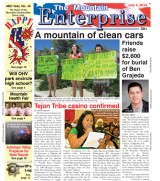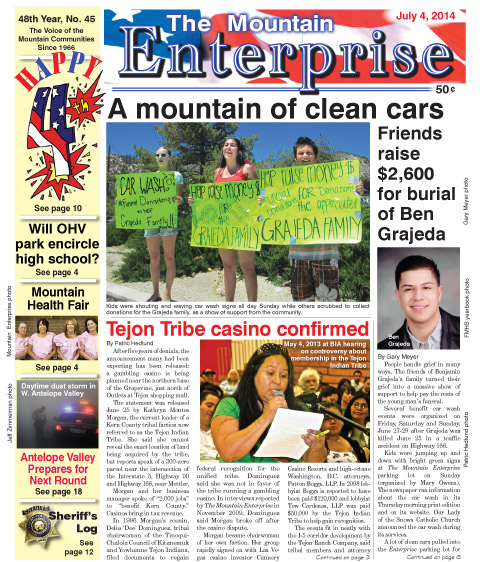Western Antelope Valley prepares for the next round
By Patric Hedlund
Residents of the Western Antelope Valley are preparing for the next round in their battle to gain honest partnership with the utility-scale renewable energy developers that are gobbling up their area. Thirty-one such corporations are projected to be seeking to install facilities in the area—roughly between Interstate 5 and Highway 14.
First Solar is the company which built the first two facilities. They scraped all the ground cover from their property and failed to use construction techniques to effectively suppress dust. Combined with natural events such as fierce winds and a three-year drought, surface grading of desert soils results in a shocking increase in the severity of dust storms—gigantic airborne clouds of sand and spores that amplify the danger of Valley Fever and create misery for the animals and humans who live there.
First Solar also promised landscaping to shield the visual blight of the facilities. That did not happen. Los Angeles County did not intervene to help residents. Local residents feel distant county, state and national government agencies have not been responsive to their concerns.
Richard Skaggs, president of the Oso Town Council Conservancy, wrote a letter to newcomer to the area, MidAmerican Solar, which is having SunPower Corp. of San Jose build a 3,230-acre, 579-megawatt development straddling Kern and L.A. County lines.
Skaggs wrote them on June 25: “We were recently bamboozled by First Solar. They were among the first companies to arrive in our area and we mistakenly thought they were dealing with us in good faith. As they say ‘fool us once…’ [We] are very much on our guard when dealing with subsequent power companies.
“Any perceived irregularity is viewed with extreme suspicion. Don’t blame us—blame First Solar. They set up the current playing field.”
Communities are reaching out for knowledge and solutions. On that same day, June 25, Robert Kerekes, president of the original Antelope Acres Town Council, and his colleagues held a full-day workshop with scientists from U.C. Riverside. Their goal is to learn about best practices in renewable facility construction for effective dust suppression.
Kerekes said in his opening comments: “During the windy season of 2013, fugitive soil dust clouds in the Antelope Valley were more severe than anything most here have ever experienced before…. Just about everyone agrees that solar-based electrical production is a part of the solution [to global climate change]. Yet large solar-array facilities are in and of themselves environmentally destructive….
“Isn’t it possible to build these facilities in the desert while enhancing it? How do we do it? One of our immediate problems is what to do with already-existing solar facilities, ones currently being built and those coming in the immediate future.
“Revegetation and reclamation—as well as a better understanding of the desert—are needed. How do we get that underway? How do we bring the political solutions into being? How will construction companies come to adopt the principle that preparing the desert up front is a lot easier than trying to fix it all after the fact?
“The answers to these and other questions will be explored at this workshop [to discover] environmental, regulatory, economic and social solutions.”
The program included desert ecology experts, air quality control regulators, farming and erosion advisors and a specialist on environmental revegetation.
Kerekes said his council seeks to form coalitions with residents in other counties with the same concerns.
Photo caption:
Left, Towering dust storm slamming toward homes in Antelope Acres carrying fugitive dirt and possibly Valley Fever spores.
To see full stories with photos, please go to The Mountain Enterprise e-Edition
(login required)
Have your newspaper delivered via mail and include internet access! Just call 661-245-3794.
Or step out and get it right now! This story and others are available right now at newsstands throughout the Mountain Communities in The Mountain Enterprise.
This is part of the July 4, 2014 online edition of The Mountain Enterprise.
Have an opinion on this matter? We'd like to hear from you.

![Towering dust storm slamming toward homes in Antelope Acres carrying fugitive dirt and possibly Valley Fever spores. [Jeff Zimmerman photo]](https://mountainenterprise.com/wp-content/uploads/IMG_7285news-324x216.jpg)

